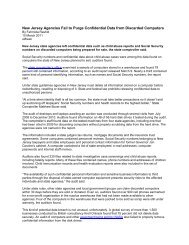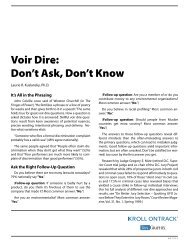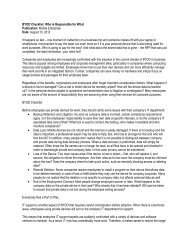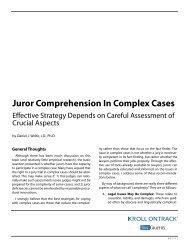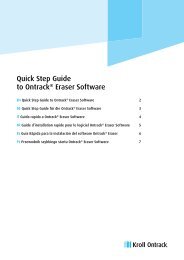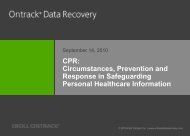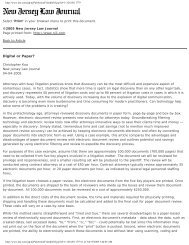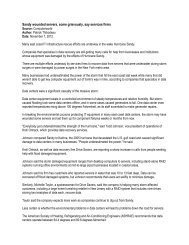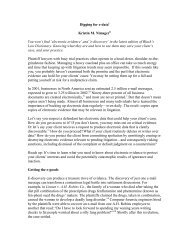Electronic Discovery and Computer Forensics Case List - Kroll Ontrack
Electronic Discovery and Computer Forensics Case List - Kroll Ontrack
Electronic Discovery and Computer Forensics Case List - Kroll Ontrack
You also want an ePaper? Increase the reach of your titles
YUMPU automatically turns print PDFs into web optimized ePapers that Google loves.
of fiduciary duty <strong>and</strong> breach of contract. The appellate court affirmed the trial court’s order issuing a<br />
preliminary injunction against the defendants, requiring the preservation of electronic evidence <strong>and</strong><br />
ordering them to allow a court-appointed expert to copy the data, recover lost or deleted files, <strong>and</strong><br />
perform automated searches of the evidence under guidelines agreed to by the parties or<br />
established by the court.<br />
� Perfect 10, Inc. v. Cybernet Ventures, Inc., 213 F. Supp. 2d 1146 (C.D.Cal. 2002). In a copyright<br />
<strong>and</strong> trademark infringement action, the court refused to find that all evidence printed from websites<br />
is inauthentic <strong>and</strong> inadmissible. Instead, the court found that the printouts were properly<br />
authenticated under Fed.R.Evid. 901(a) where the plaintiff’s CEO adequately established that the<br />
exhibits attached to his declaration were “true <strong>and</strong> correct copies of pages printed from the Internet<br />
that were printed by [him] or under his direction.”<br />
� Lombardo v. Broadway Stores, Inc., 2002 WL 86810 (Cal. Ct. App. Jan. 22, 2002). The court<br />
upheld sanctions where the defendant destroyed computerized payroll data that was the subject of<br />
the plaintiff’s discovery request.<br />
� Pennar Software Corp. v. Fortune 500 Sys. Ltd., 2001 WL 1319162 (N.D.Cal. Oct. 25, 2001). In<br />
a breach of contract suit, the court imposed sanctions upon the defendant in the form of attorney’s<br />
fees for committing spoliation of evidence <strong>and</strong> prolonging the discovery process. The court based<br />
its findings on the defendant’s failure to present a maintenance policy, log files, or backup tapes<br />
that would track the website maintenance <strong>and</strong> deletion procedures. When the evidence was<br />
produced, the court found that the defendant tampered with <strong>and</strong> deleted evidence in order to evade<br />
personal jurisdiction.<br />
� Unnamed Physician v. Board of Trustees of St. Agnes Medical Center, 113 Cal.Rptr.2d 309<br />
(Cal. Ct. App. 2001). In a physician review hearing, the hospital was ordered to provide the<br />
physician with all existing documents related to the hospital’s computer programs, except those of<br />
a proprietary nature.<br />
� In re Pacific Gateway Exchange, Inc., 2001 WL 1334747 (N.D.Cal. Oct. 17, 2001). In a securities<br />
violation case, the court lifted the discovery stay, stating “The court finds that there is a significant<br />
risk that relevant documents, both paper <strong>and</strong> electronic, could be irretrievably lost, which could<br />
result in prejudice to plaintiffs.”<br />
� Benton v. Allstate Ins. Co., 2001 WL 210685 (C.D. Cal. Feb. 26, 2001). The court refused to<br />
grant a continuance on the defendant’s summary judgment motion where the plaintiff claimed that<br />
he had not had an adequate opportunity to conduct discovery of the defendant’s computer system.<br />
The court concluded that the plaintiff did not show that a further continuance was necessary to<br />
prevent irreparable harm or that further discovery will enable him to obtain evidence essential to his<br />
opposition to the motion.<br />
� Adobe Sys., Inc. v. Sun South Prod., Inc., 187 F.R.D. 636 (S.D. Cal. 1999). In a computer piracy<br />
suit, the court denied the plaintiff’s ex parte application for a temporary restraining order. The court<br />
based its decision on the fact that it is more difficult to erase evidence that is magnetically encoded<br />
on a computer hard disk than it is to physically destroy floppy disks, compact discs, invoices, <strong>and</strong><br />
other tangible forms of evidence. “Manual or automated deletion of that software may remove<br />
superficial indicia, such as its icons or presence in the user’s application menu. However, telltale<br />
traces of a previous installation remain, such as ab<strong>and</strong>oned subdirectories, libraries, information in<br />
system files, <strong>and</strong> registry keys…Even if an infringer managed to delete every file associated with<br />
the plaintiffs’ software, the plaintiffs could still recover many of those files since the operating<br />
system does not actually erase the files, but merely marks the space consumed by the files as free<br />
for use by other files.”<br />
250




